|
Week 9: September 26 - October 2, 2010 |
Welcome
to the McGill Bird Observatory weekly report.
Click here for a complete listing of our archives.
Comments or
questions are welcome at "mbo AT migrationresearch.org".
|
PICTURE
OF THE WEEK: |
|
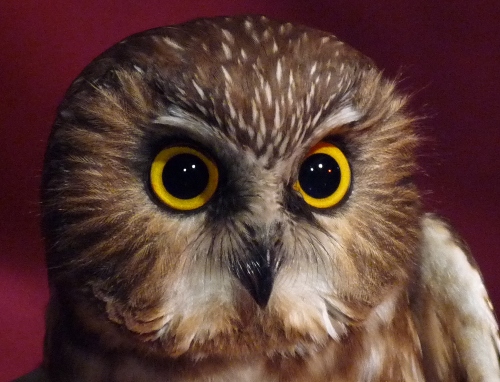
This week we resumed our Northern Saw-whet Owl Migration Monitoring Program. This
year we will for the first time attempt to have full coverage of their migration season, from
late September to early November (except for nights with rain or high winds). With 20 owls
already banded this week (including an Eastern Screech Owl), we are off to a
great start!
(Photo by Marcel Gahbauer)

|
MBO
gratefully acknowledges funding from the Support Grant and Research Committees of Bird Protection Quebec, enabling us to provide full coverage of the Northern Saw-whet Owl season for the first time.
|
|
|
|
THIS WEEK |
THIS FALL |
2010 TOTAL |
SITE TOTAL |
|
# birds (and species) banded |
1085 (36) |
4143 (68) |
5018 (78) |
28527 (106) |
|
# birds (and species) repeat |
172 (9) |
530 (36) |
744 (48) |
5085 (68) |
|
# birds (and species) return |
2 (2) |
32 (16) |
164 (31) |
784 (37) |
|
# species observed |
68 |
126 |
155 |
202 |
|
# net hours |
274.5 |
4302.5 |
7861.9 |
47769.1 |
|
# birds banded / 100 net hours |
395.3 |
96.3 |
63.8 |
59.7 |
|
|
Note: table does not include nocturnal banding (owls) |
|
Bander-in-charge: Simon Duval, Kristen Keyes
Assistants: Bob Barnhurst, Christine Barrie, Mike Beaupré, Jane Cormack, David Davey, Anna de Aguayo, Jean Demers, Steve Dumont, Barbara Frei, Jo-Annie Gagnon, Tiffany Gilchrist, Gay Gruner, Marie-Anne Hudson, Marie-France Julien, Pia Kakoranta, Le Duing Lang, Andrée-Anne Laviolette, Lance Laviolette, Barbara MacDuff, Betsy McFarlane, Chris Murphy, Marissa Nolan, Sonia Rousseau, Clémence Soulard, Bonnie Soutar, Alex Stone, Patricia Stotland, Alexis Thorbecke, Rodger Titman
Notes: Two years ago this week we were stunned when we banded 1113 birds, more than double any previous single-week total. This year our week 9 total of 1085 is similar, but seems almost modest compared to last week's 1279. Of course in reality it was another very busy week, with daily banding totals ranging from 185 to 261 (aside from Tuesday and Thursday, when we were rained out), and the rate of birds banded per 100 net hours was even higher than last week's new record, at 395. Largely the high counts can be attributed to Yellow-rumped Warblers, which again dominated by a wide margin, accounting for 70% of birds banded this week (compared to 69% last week, remarkably consistent), with 100 or more of them on each of the five mornings that weather permitted us to operate the nets. In addition, we had a record number of repeats this week (172 individuals, a good jump from the previous high of 153 in week 10 of 2008), reflective of the large number of Yellow-rumped Warblers that were hanging around for at least a few days (they accounted for 141 or 82% of the repeats). Thanks again to the big team of volunteers who cheerfully helped out in so many ways throughout the week.
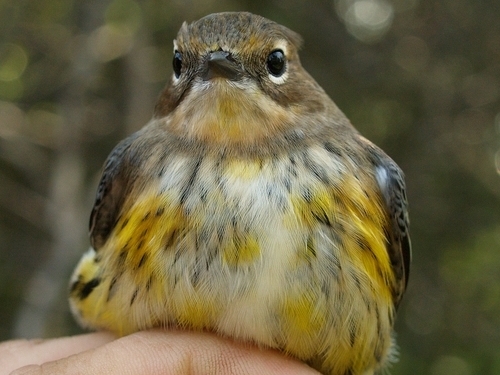
Among the many hundreds of Yellow-rumped Warblers, this one stood out due to the amount of yellow scattered across its breast, as well as a few traces on its back and rump (see other photos). Although there was some speculation of it being a hybrid, most seem to think it is just a matter of atypical pigmentation.
(Photo by Simon Duval)
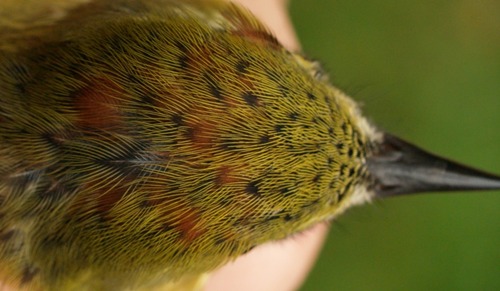
Speaking of unusual patterns, this one isn't atypical for the bird in question, it just isn't one we see very often at MBO. Try to figure out what it is; the identity will be revealed further on in the report.
(Photo by Simon Duval)
|
Despite the flurry of banding activity this week, lots of observations were also made, including a total of 54 species on October 2, which is the greatest diversity of any day so far this fall, and not likely to be topped, since our peak is usually earlier in the season. Despite that, the total of 68 species observed for the week was still well below the 71 to 79 in previous years. Among this week's birds were five seen for the first time this fall, bringing the cumulative total for the season to 126, well within the range of 125 to 128 species by the end of week 9 in four of the five previous years (though lower than the 132 recorded in 2007). The newly observed species were Snow Goose, Common Merganser, Common Loon, Great Horned Owl, and a couple of unusually early Fox Sparrows; the owl and merganser were also new records for 2010. Purple Finch was banded for the first time this year, and we also finally had our first House Wren of fall, presumably one of the local breeders that has just managed to avoid the nets until now.
This week’s top 10 [last year's rank for this week in brackets]
# individuals banded |
mean # individuals observed daily |
1. Yellow-rumped Warbler (750) [1] |
1. Canada Goose (1147.0) [2] |
2. Ruby-crowned Kinglet (82) [4] |
2. Yellow-rumped Warbler (299.4) [1] |
3. White-throated Sparrow (70) [2] |
3. White-throated Sparrow (102.7) [5] |
4. Nashville Warbler (26) [3] |
4. Blue Jay (94.0) [4] |
5. Black-capped Chickadee (15) [7] |
5. Red-winged Blackbird (91.0) [6] |
6. American Goldfinch (14) [-] |
6. American Crow (87.0) [3] |
7. Magnolia Warbler (11) [7] |
7. Ruby-crowned Kinglet (39.7) [-] |
8. Golden-crowned Kinglet (10) [-] |
8. Black-capped Chickadee (27.7) [8] |
8. Common Grackle (10) [-] |
9. Common Grackle (25.3) [-] |
10. Blue Jay (9) [6]
10. Tennessee Warbler (9) [4]
10. Song Sparrow (9) [9]
|
9. American Robin (25.3) [9]
|
|
For a second week in a row, Yellow-rumped Warbler absolutely dominated the list of birds banded. On each of the five days with good weather, we banded more Yellow-rumped Warblers than we did in the full 2009 fall season! The next three species on the list shuffled in position from last week, with Ruby-crowned Kinglet jumping into second place (where it has been for week 9 in four of the previous five years), bumping White-throated Sparrow and Nashville down one spot each, and making the top four ranking identical to this week in 2008. Another 11 Magnolia Warblers this week brought the season total to 258, second only to the 1660 Yellow-rumped Warblers, and just a few short of the high count of 264 set in 2008. We are likely near the tail end of Tennessee Warbler migration at last, but they still held on in the top ten, increasing their record count for the season to 114. Blue Jay also dropped into a tie for tenth place, but the 9 additional birds banded this week raised the season total to 36, which is another new record. Black-capped Chickadees moved up into fifth place, and we have now banded 75 so far this fall, which is unusually high for an "even" year at MBO.
Although the daily average count of Yellow-rumped Warblers rose incredibly to nearly 300 this week, they were bumped out of top spot among species observed by Canada Goose, which to date has always dominated in week 9, and in this instance did so in dramatic fashion thanks to flocks totaling 4750 individuals on the first day of the week alone. White-throated Sparrow numbers swelled this week too, reaching an average of just over 100 daily, while yet another Blue Jay record was set with daily counts averaging 94 and ranging as high as 207 on September 27! This might well be the first time that Blue Jays outnumbered American Crows over the course of a week, even though the latter still were in good numbers too. The daily count of Black-capped Chickadees and American Robins increased slightly, though their ranks were unchanged, while Ruby-crowned Kinglet and Common Grackle were new additions near the bottom of the list, displacing European Starling and American Goldfinch.
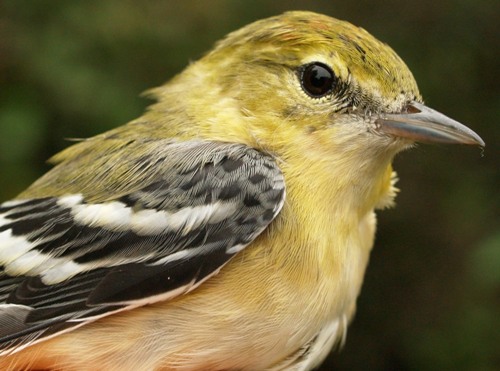
Here's another photo of the mystery bird from earlier in this week's report - a boldly marked after-hatch-year male Bay-breasted Warbler. It was just the sixth Bay-breasted Warbler banded at MBO this fall, but yes, even that is a record high count for yet another warbler species. It also is the first time we have banded one as late as this (we caught it on the second last day of week 9, October 1).
(Photo by Simon Duval)
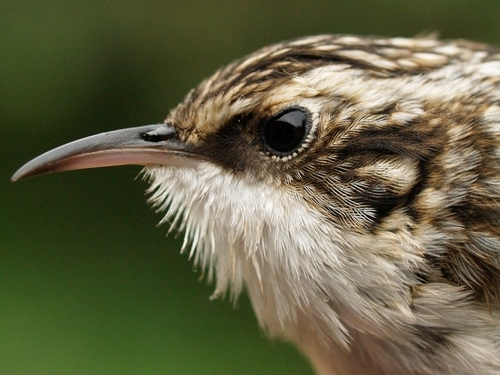
Like Bay-breasted Warblers, we never band a lot of Brown Creepers, our highest total for a season ever being just 12 of them. Late September and early October is the peak of their migration at MBO, and we were happy to have this one visit us amidst the flocks of warblers.
(Photo by Simon Duval)
|
As noted in association with the photo of the week, we have now entered Saw-whet Owl season too (just because mornings aren't busy enough these days!). This marks the first time that we are trying to cover all rain-free nights during the owl migration season, a level of coverage possible only due to support from Bird Protection Quebec, and the willingness of McGill MSc student (and Short-eared Owl researcher) Kristen Keyes to carry the bulk of the load (five nights per week) as bander-in-charge. We hope that if this season is a success we'll be able to find both funding and staff to continue a similar level of monitoring in the future, in order to permit more standardized comparisons across years. Certainly the early indications are promising, with 20 owls banded this week, including an impressive count of 15 on the final night of the week, October 2.
|
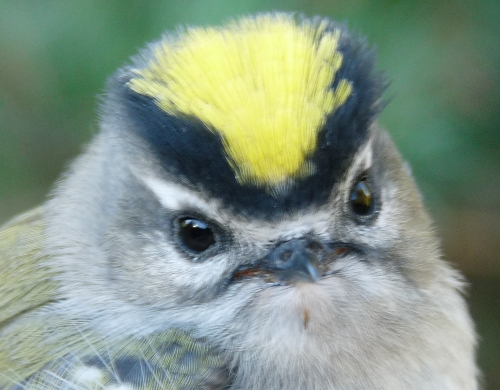
Golden-crowned Kinglets are the tiniest bird we band at MBO, and also considered one of the cutest by many of our volunteers not only due to their size, but also their high-pitched vocalizations and their tendency to flare their crests, as this female (above) and male (below) have done for the camera, nicely showing off their colours.
(Photos by
Marcel Gahbauer)
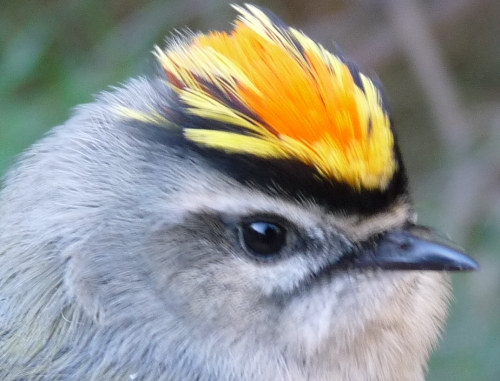
|








